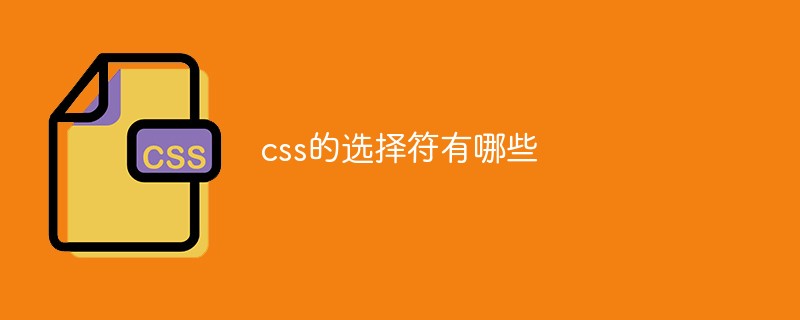Home >Web Front-end >Front-end Q&A >What are the selectors in css?
What are the selectors in css?
- 青灯夜游Original
- 2021-04-28 13:50:337278browse
css selectors include: 1. Wildcard selector "*"; 2. ID selector; 3. Class selector; 4. Tag selector; 5. Adjacent selector "E F"; 6 , sub-selector "E>F"; 7. Descendant selector "E F"; 8. Pseudo-class and pseudo-element selectors, such as ":first"; 9. Attribute selector.

The operating environment of this tutorial: Windows 7 system, CSS3&&HTML5 version, Dell G3 computer.
css selector (selector) is a specification used to specify which dom element or elements the css style is used for.
Each css style definition consists of two parts, the form is as follows: Selector {style} The part before {} is the "selector".
The "selector" specifies the object (dom object) of the "style" in {}, that is, which elements in the web page the "style" acts on.
What are the css selectors (selectors)?
1. Wildcard selector (*): matches any element.
2. ID selector (# myid): matches any element whose ID is equal to "myid".
3. Class selector (.myclassname): Match any element whose class is equal to "myclassname".
4. Label selector (div, h1, p): Select the specified element name All elements.
5. Adjacent selector (E F): used to select (not internally) the element immediately following the specified first element.
6. Child selector (E > F): used to select elements with specific parent elements, for example ul > li, select all < each < whose parent is
- element li> element. (Learning video sharing: css video tutorial)
- [attribute]: used to select elements with specified attributes.
- [attribute=value]: Used to select elements with specified attributes and values.
- [attribute~=value]: Used to select elements whose attribute value contains the specified vocabulary.
- [attribute|=value]: Used to select elements with attribute values starting with the specified value, which must be the entire word.
- [attribute^=value]: Matches every element whose attribute value starts with the specified value.
- [attribute$=value]: Matches every element whose attribute value ends with the specified value.
- [attribute*=value]: Matches every element whose attribute value contains the specified value.
7. Descendant selector (EF): used to select elements inside the element.
8. Pseudo-class and pseudo-element selectors: used to add special effects to certain selectors.
| :active | :any-link | :blank | :checked | :current | :default |
| :defined | :dir() | :disabled | :drop | :empty | :enabled |
| :first | :first-child | :first-of-type | :fullscreen | :future | :focus |
| :focus-visible | :focus-within | :has() | :host | :host() | :host-context() |
| :hover | :indeterminate | :in-range:invalid | :is() | :lang() | :last-child |
| :last-of-type | :left | :link | :local-link | :not() | :nth-child() |
| :nth-col() | :nth-last-child() | :nth-last-col() | :nth-last-of-type() | :nth-of-type() | :only-child |
| :only-of-type | :optional | :out-of-range | :past | :placeholder-shown | :read-only |
| :read-write | :required | :right | :root | :scope | :target |
| :target-within | :user-invalid | :valid | :visited | :where() |
Introduction to Programming! !
The above is the detailed content of What are the selectors in css?. For more information, please follow other related articles on the PHP Chinese website!

